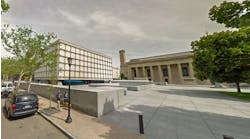Preventive maintenance improves the safety and security of students, staff and visitors and may increase the return on investment of a security system. Simple checks on doors, locks, key systems, hardware and software will save schools time and money and provide peace of mind.
Proper planning starts with asking the right questions about existing facilities. Answering some basic questions about on-site safety and security may reduce costs and help identify areas that need improvement. Identify what is working and what needs attention to keep a school—and budget—in great shape.
Safety checklist
When reviewing a school’s safety and security measures, break it down into three areas:
•Locks/key systems. Mechanical locks are a security staple and serve as an effective safety precaution as long as schools have top-quality locks, a defined key system and a plan to manage the keys. If an institution doesn’t already have a high-security key system, upgrading to one will improve security by preventing unauthorized key duplication. However, education institutions should minimize the number of keys issued and set up an automated lockdown in an emergency.
Mechanical locks and key systems, as well as electronic locks, require proper maintenance to ensure they work correctly and keep doors secured reliably. Some issues to consider when planning a preventive maintenance program:
-What type of key system is used: open keys or patented, high-security keys?
-Does the school have a designated place and employee responsible for mechanical and master keys, as well as electronic credentials?
-Does the school have a data-management system to protect a key/credential system?
-Do doors close and latch every time in all types of weather?
-Are locksets with levers exposed in an area where they could be vandalized?
-Have knobs been replaced with levers to accommodate people with disabilities?
-Is there uncontrolled access anywhere in the facility or campus?
-Are there any doors that are frequently wedged or propped open?
•Other door hardware. Door hardware is another important element of overall security. Door closers, exit devices, automatic openers, digital surveillance equipment and other accessories around a door opening need to be maintained regularly to ensure they are working properly. Although these devices don’t always affect the actual locking or unlocking of the door, they may affect how reliably the door latches. Door hardware also controls how safely and easily doors operate—on an everyday basis and in an emergency. Regular preventive maintenance extends the life of door hardware, giving a lower cost of ownership and enhancing overall safety and security.
To ensure that other door hardware is in good working order, answer these questions:
-Are the tension adjustments to specification on all door closers?
-Are exit devices well-maintained and functioning properly (including both rim and top/bottom rod devices)?
-Do hinges have non-removable pins for out-swinging exterior doors?
-Do ADA-compliant doors meet the less-than-5 pounds manual opening force requirement?
-Do fire-rated openings have all original hardware, or code-compliant hardware as indicated on the opening?
-Do automatic operators meet ANSI/BHMA speed and force requirements?
-Are any door closers or exit devices missing covers or end caps?
-Are all of fire doors labeled clearly?
-Are there any gaps greater than ⅛-inch between doors and frames?
-Are classrooms, offices and gathering areas equipped with panic-notification devices?
-Are all surveillance cameras around exterior doors working properly?
•Security technology. Maintaining the software that operates security technology is another important part of preventive maintenance. This may involve installing updates and backing up data according to the manufacturer’s recommendations. These tasks will keep security software up-to-date for access control and help maintain optimal security throughout a campus.
When updating security technology, here are a few things schools may want to review:
-Is the software for all of the access-control equipment updated? Are there new features available that may be useful?
-Has the school installed the most recent version of software for complete access control?
-Is the software protected against potential viruses that could compromise its functionality?
-Are there new reports that should be run for the upcoming year? Are they scheduled to be e-mailed automatically?
-Are there students, staff or faculty who no longer are at school whose credentials have not been deleted?
-Are the hardware and software communicating properly?
-Have there been any recent alarms from the system’s health monitor that would indicate a communication problem?
-Have there been any recurring alarms that might indicate a hardware problem?
-Has the institution reviewed audits to see if doors are propped frequently?
-Have offline locks been toured to provide updates or obtain audits?
-Have new operators been trained? Is additional training required? Has there been any turnover that would affect this?
-Are there high-risk areas that should be monitored with digital video?
-What is the escalation process in the event of an alarm? Is this process properly mapped out within the system? Has there been any turnover that would affect this?
-Is the card printer working properly? Are there enough printer ribbons to meet upcoming needs?
Preventive maintenance begins with planning. Through careful planning, education institutions can determine what is working and if any equipment, hardware or software needs to be replaced or upgraded. It’s also important to remember that the cost of ownership is reduced greatly when schools proactively perform preventive maintenance.
Youngkin is marketing manager, education market, for Ingersoll Rand Security Technologies, Carmel, Ind., and can be reached at [email protected].

